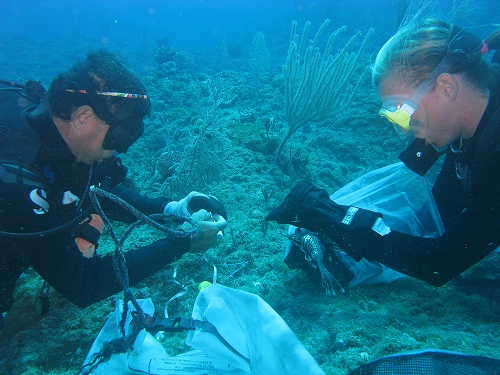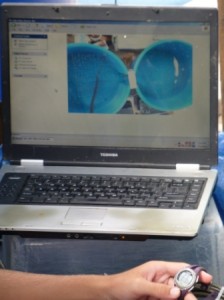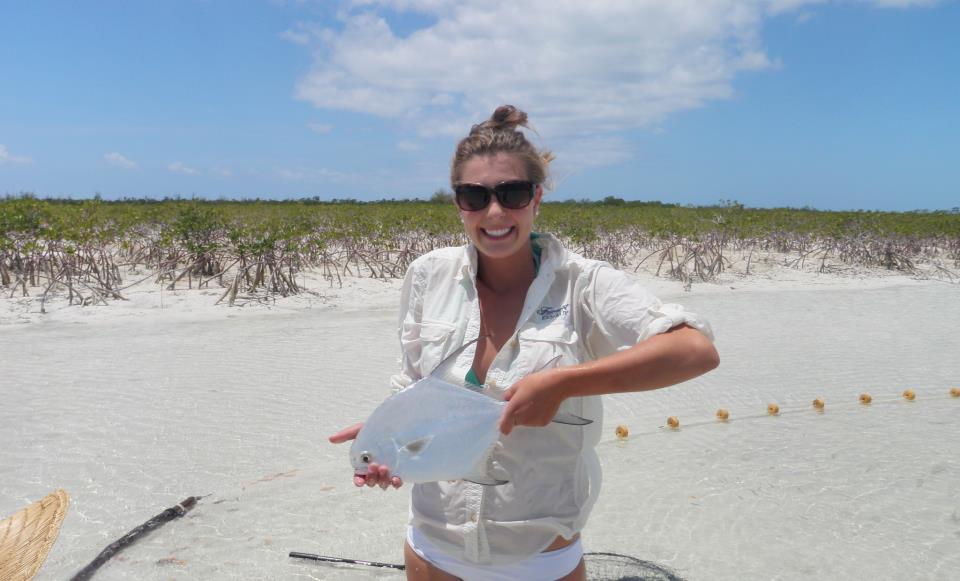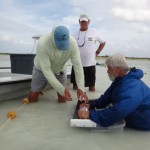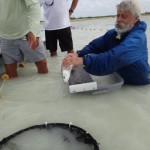Monthly Archives: November 2012
Fall 2012 Cobia Harvest
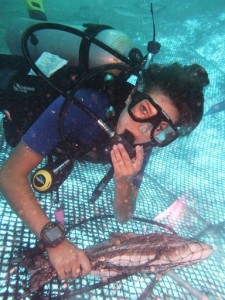 For the first time in almost 3 years the aquaculture team is harvesting fish from their offshore cage! The fish will be eaten in the Island School’s dining hall as a demonstration of a community-based aquaculture program that is focused on producing local food, while also reducing fishing pressure on wild fish stocks around South Eleuthera. We all ate cobia for breakfast on Thursday! All of the harvested fish carcasses will be used to make silage that will eventually be used to make tilapia and pig food. This is an attempt to produce as little “waste” as possible, and a way to utilize all of the nutrients that are lost after the fish is filleted as a way to produce more food.
For the first time in almost 3 years the aquaculture team is harvesting fish from their offshore cage! The fish will be eaten in the Island School’s dining hall as a demonstration of a community-based aquaculture program that is focused on producing local food, while also reducing fishing pressure on wild fish stocks around South Eleuthera. We all ate cobia for breakfast on Thursday! All of the harvested fish carcasses will be used to make silage that will eventually be used to make tilapia and pig food. This is an attempt to produce as little “waste” as possible, and a way to utilize all of the nutrients that are lost after the fish is filleted as a way to produce more food.
 As you may remember, CEI outfitted the offshore cage with Predator-X netting that was donated by the materials company DSM, www.dsm.com, and the net production company Net-Systems, www.net-systems.com. We are happy to announce that this netting did survive shark predation attempts, showing minimal damage from any shark bites it did endure. The netting, in conjunction with adequate cage maintenance (such as removal of any dead fish and regular cleaning) is the answer to the aquaculture program’s major problem of fish escapement, and will lead to yearly cobia growouts and year-round harvest.
As you may remember, CEI outfitted the offshore cage with Predator-X netting that was donated by the materials company DSM, www.dsm.com, and the net production company Net-Systems, www.net-systems.com. We are happy to announce that this netting did survive shark predation attempts, showing minimal damage from any shark bites it did endure. The netting, in conjunction with adequate cage maintenance (such as removal of any dead fish and regular cleaning) is the answer to the aquaculture program’s major problem of fish escapement, and will lead to yearly cobia growouts and year-round harvest.
Another expedition starts for the Historic Bahamian Shark Abundance Project
November marks the beginning of CEI’s Shark Research and Conservation Program’s third field expedition for the Historic Bahamian Shark Abundance Project. Led by Shark Research and Conservation Program Director, Edd Brooks, and Jeff Stein, Senior Research Scientist from the University of Illinois, the project is replicating a series of fisheries-independent longline surveys, which took place over 30 years ago, from 1975-1982.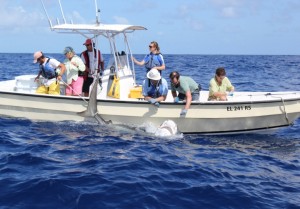 The original dataset was collected by Captain Stephen Connett of the vessel R/V Geronimo, which conducted the initial surveys on the shallow bank known as “the bridge,” that connects the southern tip of Eleuthera to the northern tip of Cat Island. The initial surveys documented a total of six species, however the majority of the catch was dominated by tiger sharks (Galeocerdo cuvier) at 54% of the catch, and Caribbean reef sharks (Carcharhinus perezi) at 33%.
The original dataset was collected by Captain Stephen Connett of the vessel R/V Geronimo, which conducted the initial surveys on the shallow bank known as “the bridge,” that connects the southern tip of Eleuthera to the northern tip of Cat Island. The initial surveys documented a total of six species, however the majority of the catch was dominated by tiger sharks (Galeocerdo cuvier) at 54% of the catch, and Caribbean reef sharks (Carcharhinus perezi) at 33%.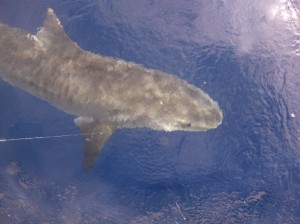
Funding for four expeditions to the bridge was obtained in 2011 and to date two have been completed. Preliminary analysis of data from the previous expeditions (November 2011, March 2012) is already providing us with some valuable results. After 12 scientific longline sets the crew has caught 84 sharks from three species and has documented a shift in the assemblage compared to the historical dataset. Now, Caribbean reef sharks represent 67% of the catch and tiger sharks only 31%. Continue reading
Prawns + Aquaponics = Three Course Meal!
The aquaponics system at CEI produces enough lettuce to feed our community twice a day, seven days a week. The fish production is increasing in the next year, and provides one meal a week of fresh tilapia. Right now the system is good, but does have a few minor opportunities for improvement. One issue we are facing is an over-abundance of solid waste settling out at the bottom of our deep water hydroponic beds. One way to solve this “problem” is to install additional filters which would have to be purchased, shipped, installed, and run on electricity. The filters would use more fresh water to clean, and require more time and maintenance. This isn’t the ideal solution when we are trying to reduce imports, simplify operations, maintain affordability, and conserve water. 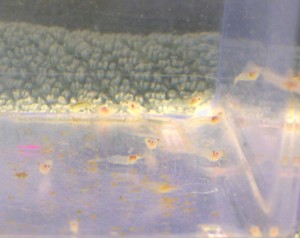
We instead looked for a permaculture way of solving the solid waste issue, and found one!Last Friday a shipment arrived at Governors Harbor Airport of three small boxes from a company in Florida called Miami-Aquaculture Inc. Inside the three boxes were approximately 2,000 post-larval giant freshwater prawns (Macrobrachium rosenbergii) which can grow to twelve inches in length in just one year. Continue reading
Lionfish Program Update
October was a packed and exciting month for CEI’s Lionfish Research and Education Program (LREP). A new study tagging lionfish in a novel way is currently happening at CEI. This monitoring technique can help us track when, where, and how the lionfish are spawning. The hopes are that in the future we will be able to more effectively reduce population sizes.
Dr. Lad Akins, director of the Reef Environmental Education Foundation (REEF), spent a week at CEI to help make this project happen. Under his direction, accompanied by new LREP manager Dr. Jocelyn Curtis-Quick and interns, several acoustic receivers were placed at the edge of the Exuma Sound. Divers previously scouted this area to identify hotspots, or areas where several lionfish were found together, to place these receivers. After the receivers were set up, lionfish were captured to place tags inside their guts. This required underwater surgery on the lionfish, a procedure that had never been done before. Previously, when fish had been tagged, they had to be brought to the surface. Continue reading
New shuttle box trials being conducted at CEI
CEI recently started performing shuttle box experiments in the wet lab. The set-up of the shuttle box system is simple: two tanks are connected through a short “walkway”, and above the tanks a camera is mounted to monitor the fish movements, with little human interference on fish behavior.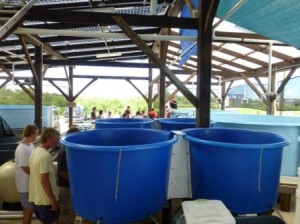 The shuttle box trials complement the critical temperature experiments that the Flats team wrapped up in early October 2012. These experiments tested the range of temperatures that a fish can tolerate before losing equilibrium, and are used to study how the projected conditions for climate change will affect fish in the flats ecosystems.
The shuttle box trials complement the critical temperature experiments that the Flats team wrapped up in early October 2012. These experiments tested the range of temperatures that a fish can tolerate before losing equilibrium, and are used to study how the projected conditions for climate change will affect fish in the flats ecosystems.
The shuttle box comes provides a unique aspect while studying effects of climate change, by adding a behavioral decision-factor element to the study. Trials will be run using one the common mangrove prey species (bonefish, yellowfin mojarra, yellowtail snapper and checkered puffer) in one of the two tanks and a mangrove predator (juvenile lemon shark) in the other tank. Then, the environmental conditions in the prey tank are manipulated to an unfavorable level (i.e. high temperature) and the fish is viewed on the cameras to see when it decides that being in the same tank as the lemon shark, with the threat of predation, is preferred to unfavorable environmental conditions. Continue reading
CEI researchers and affiliates meet with members of the Bahamian government to discuss marine conservation
CEI researcher Aaron Shultz along with Fisheries Conservation Foundation chair Dave Philipp, Illinois Natural History Survey Fisheries Biologist Julie Claussen, and a young member of the CEI boathouse staff Mally Goodman, took a break from their bonefish tagging efforts to meet with the Prime Minister and the Environmental Ministry of the Bahamas at Deep Water Cay, Grand Bahama on Thursday.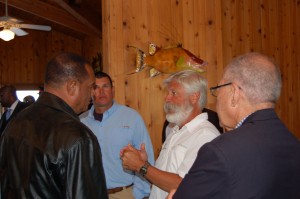 Aaron spoke to the group about conservation, and showed a slideshow on the research and tagging project currently being conducted on Abaco. Prime Minister Perry Christie talked pointedly on the importance of protecting the natural resources of the The Bahamas, as well as increasing research and education.
Aaron spoke to the group about conservation, and showed a slideshow on the research and tagging project currently being conducted on Abaco. Prime Minister Perry Christie talked pointedly on the importance of protecting the natural resources of the The Bahamas, as well as increasing research and education.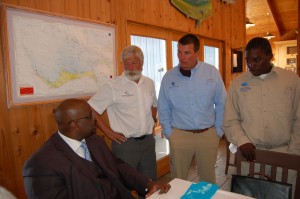
Many officials from the Bahamian government and members of the press attended the event, serving as great exposure for the Cape Eleuthera Institute, The Island School, Fisheries Conservation Foundation and Bonefish Tarpon Trust. The word is spreading on some of the work that CEI researchers are doing, great work guys!
Spotlight on Master’s student at CEI: Liane Nowell, Carleton University
I started my master’s at CEI in association with Carleton University in May 2012. I will be studying the thermal biology and spatial ecology of bonefish (for global warming implications) as a grad student in the Dr. Steve Cooke and Dr. Cory Suski labs of Carleton University and the University of Illinois, respectively.
The staff and faculty at CEI are a wonderful bunch of people. They are encouraging and eager to help me develop professionally and as a person. I really enjoy and appreciate CEI’s unique ability to engage in outdoor, experiential classrooms near Exuma sound. It’s nice to be a short boat ride away from the mangrove creeks that act as my study site. To date, I’ve been given the opportunity to work with a multi-disciplinary network of professionals including meeting and working alongside visiting world-class scientists, collaborating with other master’s students, both here and abroad, and working closely with a host of Ph.D. students at the institute. Continue reading
Educational Programs October Update
The month of October has been busy and bustling with visiting educational programs from Palm Beach Florida and Nassau.

Palm Beach Day Academy, located in South Florida, recently visited for a 5 day program where they focused on research and sustainable systems at the Island School and CEI. After spending a memorable first day tagging juvenile green sea turtles they spent the next morning with the aquaculture team for an entertaining (and delicious) presentation where they were able to eat some of the Cobia grown in the 3000 m3 offshore cage. Throughout the remainder of their trip they enjoyed a presentation and dissection on the invasive lionfish as well as an engaging bonefish dissection from the Flats researchers just to name a few.
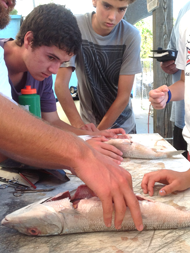 Lyford Cay International School, a K-12th grade International Baccalaureate authorized school in western New Providence, The Bahamas, brought their grade 10 students last week for a 3 day program focusing on sustainable water usage and conservation techniques at CEI/Island School. Each morning the students joined the morning chore of measuring the water in the cisterns around campus. Continue reading
Lyford Cay International School, a K-12th grade International Baccalaureate authorized school in western New Providence, The Bahamas, brought their grade 10 students last week for a 3 day program focusing on sustainable water usage and conservation techniques at CEI/Island School. Each morning the students joined the morning chore of measuring the water in the cisterns around campus. Continue reading
Bonefish tagging trip in Abaco update #1
In October, CEI researchers Aaron Shultz and Zach Zuckerman, along with Illinois Natural History Survey scientist and chair of the Fisheries Conservation Foundation Dave Philipp, took a trip to the neighboring island of Abaco to tag bonefish, as part of a Caribbean-wide effort to gain knowledge on the population dynamics and movements of these economically important gamefish.
Tagging efforts on Abaco were a huge success, despite having to deal with Hurricane Sandy. Early on in the trip, the team headed out to the Southern End of the Marls and captured several schools of bonefish that came in waves of 50-150 fish. Buddy Pinder, bonefish guide and member of the Abaco Flyfishing Guides Association helped them tag 162 fish on the first day of seining. The next day they saw piles of fish moving along the same shoreline and tagged an additional 496 bonefish! One of the fish had been tagged by Aaron two years earlier in Cross Harbour. The team suspects these fish are using this stretch of shoreline as a corridor to the southern end of the island, where fish aggregate prior to spawning.

